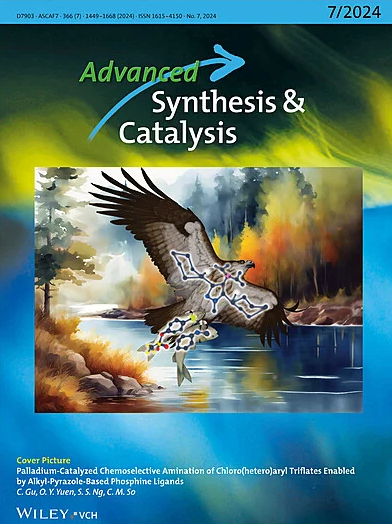N‐Heterocyclic Carbenes (NHCs): An Emerging Efficient Catalyst in Amide Bond Formation
IF 4
2区 化学
Q2 CHEMISTRY, APPLIED
引用次数: 0
Abstract
Since the discovery of N‐heterocyclic carbenes (NHCs), their role as ligands and organocatalysts has grown significantly due to their unique umpolung reactivity and strong σ‐donor capabilities. In recent years, the field of amide bond formation has seen notable advancements through NHC catalysis. Given the wide application of amides in pharmaceuticals, agrochemicals, and materials science, several NHC‐based strategies have emerged for synthesizing amides from substrates such as aldehydes, alcohols, esters, and nitriles. This review highlights the sustainable and efficient nature of NHC‐catalyzed amide bond formation. Both metal–NHC complexes and metal‐free NHCs offer diverse catalytic pathways, with Ru–NHC systems proving especially effective in redox‐neutral amidations. NHCs promote reactions through mechanisms involving acyl azolium, hemiaminal, and Breslow intermediates, enabling high selectivity under mild conditions. Many of these methods align with green chemistry principles, featuring high atom economy and minimal waste generation. The versatility and tunability of NHC catalysts allow broad substrate compatibility, and recent innovations include metal‐free organocatalysis, continuous flow processes, and electrochemical amidation strategies. This review presents a comprehensive analysis of NHC‐catalyzed amide formation, summarizing key mechanisms, substrate scope, and catalyst design, emphasizing their dual role in metal‐based and organocatalytic sustainable amidation methods.

n -杂环碳烯(NHCs):一种新兴的酰胺键形成的高效催化剂
自从n -杂环碳化合物(NHCs)被发现以来,由于其独特的非均匀反应性和强的σ给体能力,它们作为配体和有机催化剂的作用得到了显著的发展。近年来,通过NHC催化酰胺键形成领域取得了显着进展。鉴于酰胺在制药、农用化学品和材料科学中的广泛应用,几种基于nhc的策略已经出现,用于从底物(如醛、醇、酯和腈)合成酰胺。本文综述了nhc催化酰胺键形成的可持续和高效性质。金属- nhc配合物和无金属nhc都提供多种催化途径,其中Ru-NHC系统在氧化还原中性酰胺中特别有效。NHCs通过涉及酰基唑、半胺和Breslow中间体的机制促进反应,在温和条件下实现高选择性。这些方法中的许多都符合绿色化学原理,具有高原子经济性和最小废物产生的特点。NHC催化剂的多功能性和可调性允许广泛的底物兼容性,最近的创新包括无金属有机催化,连续流过程和电化学酰胺化策略。本文综述了nhc催化酰胺形成的综合分析,总结了关键机制,底物范围和催化剂设计,强调了它们在金属基和有机催化可持续酰胺化方法中的双重作用。
本文章由计算机程序翻译,如有差异,请以英文原文为准。
求助全文
约1分钟内获得全文
求助全文
来源期刊

Advanced Synthesis & Catalysis
化学-应用化学
CiteScore
9.40
自引率
7.40%
发文量
447
审稿时长
1.8 months
期刊介绍:
Advanced Synthesis & Catalysis (ASC) is the leading primary journal in organic, organometallic, and applied chemistry.
The high impact of ASC can be attributed to the unique focus of the journal, which publishes exciting new results from academic and industrial labs on efficient, practical, and environmentally friendly organic synthesis. While homogeneous, heterogeneous, organic, and enzyme catalysis are key technologies to achieve green synthesis, significant contributions to the same goal by synthesis design, reaction techniques, flow chemistry, and continuous processing, multiphase catalysis, green solvents, catalyst immobilization, and recycling, separation science, and process development are also featured in ASC. The Aims and Scope can be found in the Notice to Authors or on the first page of the table of contents in every issue.
 求助内容:
求助内容: 应助结果提醒方式:
应助结果提醒方式:


